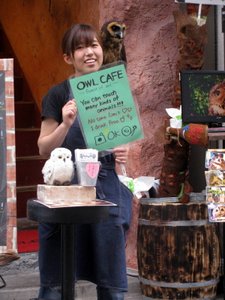Advertisement
Published: July 17th 2017

 Owl Cafe
Owl Cafe
Yes, that's a real live owl on her shoulderJust a few more short takes from Tokyo
Lolita No, it’s not what you think.
Lolita refers to a particular fashion look that some young women in Japan wear. Far from being blatantly sexy, these women dress very demurely, in full skirts with voluminous petticoats and high-necked blouses. They often wear a big bow in their hair, or sometimes a lace cap. Think of a Victorian Alice in Wonderland. This is about looking sweet and cute.
As is true of fashion for young women everywhere, there is a lot of money involved in being a Lolita girl. First is the outfit itself. This is not some obscure, cobbled together look. I visited one department store that had six whole floors (!) of Lolita fashion. The one small section of the store not devoted to Lolita was given over to fan merchandise for a boy band.
In addition to fashion, the Lolita movement also has its own magazines, as well as an official association, the Japan Lolita Association. The Japan Lolita Association has its own theme song, and is in the process of creating a Lolita certification test.
Am I the only
one who thinks these girls are taking the whole thing far too seriously??
Hanazono Shrine As I was walking toward the train station one day, I came across a narrow passage way sheltered by a torii gate. Torii gates are used to mark the entrance into a sacred space, and are found at the entrance to the grounds of a Shinto shrine. Some Buddhist temples have torii gates as well, but, torii gates are reliable indicators of the entrance to a Shinto shrine.
I like temples and shrines, so I walked through the gate. It was Sunday, and a flea market is held on the grounds every Sunday. There were piles of old books, old movie posters, and some household items, but what caught my eye was a table of old woodblock prints.
One of the vendors had prints of some of the works by the more famous artists of the late eighteenth and nineteenth centuries. One Japanese artist that I rather liked – Hiroshiga - was among the prints he had for sale. Now these were not originals, nor museum quality reproductions, but they were still printed on heavy paper, and
the colors were clear, not muddy.
He seemed delighted that I recognized the Hiroshiga prints. Now, he spoke little English, other than to tell me the prints were 3,000 yen (about USD$30) but he had a smart phone with a translation app, and so did I. With our phones talking to each other, some hand gestures, and a few laughs, we were able to do business, and we both walked away happy.
Flea market aside, this is one of the more important Shinto shrines in Tokyo. It was established in the 17
th century, and although you would never guess it from all the skyscrapers surrounding it now, it was once part of the Imperial Gardens. This is shrine dedicated to the spirit Inari, who represents prosperity, fertility, and good harvests. There is a little shrine to one side down a path that is guarded by a pair of statues of foxes. These are called kitsune, and they are messengers that carry requests from worshippers to Inari.
Odd fact: I found out later that Vincent Van Gogh had copied a number of Hiroshiga prints as part of his “Japonaiserie” series. These paintings are in the

 Van Gogh copy of Hiroshiga
Van Gogh copy of Hiroshiga
The Hiroshiga is on the left, the Van Gogh on the right
(photo courtesy of Wikipedia)collection at the Van Gogh Museum in Amsterdam.
The Owl Café One of the weirder things I came across was the Owl Café. I had heard about cat cafes in Japan, where, for a fee, you can have coffee and play with cats. That, while not my cup of tea, (pardon the pun) is at least understandable.
I found the Owl Café on a little street near the Senso-ji Temple. A young lady was standing outside passing out flyers with an owl perched on her shoulder. I didn’t realize it was a live bird until it turned its head to look at me. I didn’t go inside, but she let me touch the owl, and I can tell you that an owl’s feathers are very soft.
Possibly Useful Information The Hanazamon Shrine is on the main east-west street leading to Shinjuku Station. Look for the torii gate between a restaurant called “Jonathan’s” and a Family Mart Convenience store.
There are several Owl Cafes in Tokyo, the entrance fee runs from JPY 890 to JPY 1,500. The one I saw near Senso-ji Temple was the Forest of Owl Café
(Auro no Mori Owl Café,) but there are others.
Advertisement
Tot: 0.3s; Tpl: 0.011s; cc: 38; qc: 128; dbt: 0.1807s; 1; m:domysql w:travelblog (10.17.0.13); sld: 1;
; mem: 1.4mb














RENanDREW
Ren & Andrew
That poor owl!
I love cats, but I seriously don't like cat cafes. I don't mind the ones that help to rehome cats, but I just can't get past the hygiene issues. I've heard of rat and guinea pig cafes too - I don't understand how food standard authorities allow them to operate...